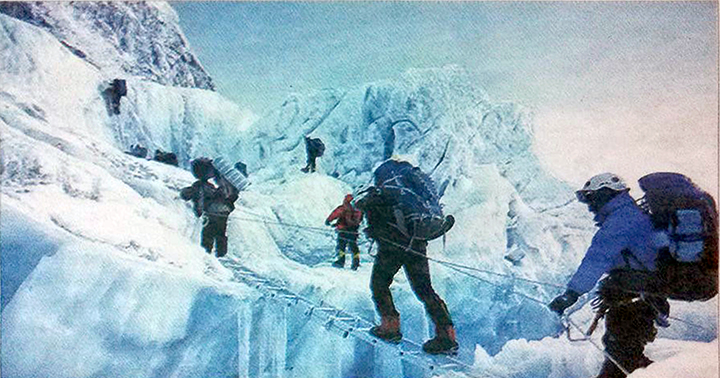By Swe Myint Moh
There are many kinds of sports in the world, dividing mainly into three groups: the first group falls into social type in which Yoga, tai ji quan and aerobic exercises are included. The second category is termed as a competitive type, playing individually or in a team. In the second group, badminton, table tennis, track and field, short put, sepak takrow, basketball, volleyball and football are included. In third category, boxing, motor racing , motorcycling, ice skating, high jump and mountaineering are included.
Facing natural disasters
Most sports tend to win or lose competition; climbing sport does not get involved with human competition, but rather it is a strange sport to overcome natural disasters. Climbing earth and rock mountains will have to suffer from wind, rain, and tiredness; exhaustive ascent and decent will be experienced but without risking one’s life. If one tries to an ice mountain over 10 000 ft high, that mountain, that mountain has rarely been inhabited by humans in its great wilderness, mountain ranges and spurs.
Crossing ice streams with strong currents, trembling with extreme cold due to heavy rainfall throughout the day, biting leeches, small and land leeches and sand flies make you itchy and swollen and scarcity of drinking water. Reaching over 10,000 ft of the mountains makes one breathless and tired due to lack of oxygen, vomiting and headache, exhaustion and sleeplessness. Staying on an ice field for a long time tends to have frostbites of limbs and toes, nose and ears and skin bruises; sometime these body parts dropped off due to the frostbites.
Practice in advance depending on the types of mountains When a mountaineering expedition is arranged, prior rigorous exercises must be taken depending on the types of mountains. Day-trip mountaineering includes Myinmathi Mountain, Hsin Mountain, East and West Mountain, Mene Mountain and Yazatri Mountain. One or two nights spent on the mountains include Victoria Mountain. 14-15 days of return-trips include camping over 10000ft high mountains: Hponkan Razi, Phangran Razi, Madoi Razi and Mount Saramati and so on.
Intending to climb these mountains, exercises must be done again and again.
Daily exercises are good for mountaineers; but mainly on Sat and Sun, at about 5 pm you have to walk carrying around 20-pounds to and fro for 12 miles with a time limit of 3 hours. This exercise must go on by setting on a weekly basis. Depending on a mountaineering expedition, you have to practice except Sat and Sun from three months to a year.
During the intervals except Saturday and Sunday, exercises could be done individually or in groups as needed. Exercises for ascents and descents of hills or short trips to overcome obstacles could be carried out. Climbing requirements and medicines need to be heeded.
While trying to climb an ice mountain, walking sticks, ice skates and ski goggles are needed. Climbers have to abide by disciplines prescribed by the club; local customs need to be heeded by climbers.
Do’s and don’ts must be abided by from the beginning and ending of the expedition. These things need to be reminded daily.
Choose the safest route
While climbers are crossing the streams with strong currents, they have to use the strong robes to avoid drifting along the strong currents. They have to use strong robes only on ascents and descents in climbing a canyon of 80-90 degrees steep and mountain walls.
Normally climbers have to seek a safety route around the mountain with rare use of robes. Climbers are divided into three groups to start climbing a mountain. First and third groups are comprised of local guides who are experienced with physical strengths. Middle group members are not only allowed to overtake the first group but also not follow the third group. Climbers who are left behind for various reasons must be guarded by the third group. While walking on an ice field, a long line of individuals headed by local experienced climber whose footprints must be treaded by other members. Missteps and loss of routes must be carefully taken into consideration. Estimating thin or thick ice is impossible, walking unstable or sinking into the snow must be heeded carefully. Even if all members reach the summit, the expedition is not finished; they have returned to the rallying place, the expedition is successfully over.
Many more climbing activities to the ice mountains
In the past, members of mountaineering expeditions, schoolchildren and tourists interested in Adventure Tour took up the task of climbing.
Nowadays, due to incredible advancement of communication equipment and fine cameras; wide knowledge and smooth transport lead to numerous trips by groups and members with the same hobbies. Many mountaineers from around the world keep climbing world-highest mountains.
Mountaineering involves taking a risk and those who want to become adventurers. It would bring a success of pure delight after overcoming various hazards, not only for themselves but also for representation of their race, region and country, they succumb to world’s highest mountains.
The number of fatalities from 1921 to 2018 while climbing Mount Everest is 293 with 11 climbers in 2019. There are other fatalities in climbing other mountains in the world. In other type of sport—boxing—the number of fatalities is about 500 with yearly average of ten. Skating, an exciting sport, involves an annual fatality rate of 20-50; motor-racing of Formula One from 1952 to 2014 suffered 14 British fatalities and 10 American fatalities from 1953 to 1975.
Taking a vow to all athletes from the sporting fields who dare to do at the risk of their own lives.
(Translated by Arakan Sein)



